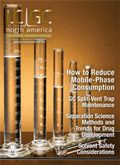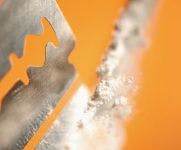The Most Common Mistakes in Solid-Phase Extraction
LCGC North America
Proper implementation is key to the performance of your SPE analyses. Look out for the common mistakes explained here.
If you use solid-phase extraction (SPE) in your work, its proper implementation is key to the performance of your analyses. Variability in the quality of SPE protocols come from some common issues, misunderstandings, and ignorance of the mechanisms that are in play.
Know Your Sorbent and Analyte Chemistry
Mixed-mode separations are the key to cleaner extracts. SPE sorbent selection follows the same rules as high performance liquid chromatography (HPLC) in terms of matching the hydrophobicity of the analyte, but more polar sorbents, those capable of hydrogen bonding and those capable of electrostatic interaction (ion exchange) with the analyte, are increasingly more selective, and therefore result in increasingly cleaner extracts. It is always beneficial to know something of the analyte structure, such as logD (LogP) and pKa values, which are all valuable in designing an optimized extraction protocol. Polar or ionizable functional groups can be used to improve selectivity through the use of more-polar sorbents or ion-exchange sorbents, and higher logD (P) values will indicate the possibility of using a less hydrophobic stationary phase, which again can help to improve selectivity, especially when the matrix is less polar.
Condition and Equilibrate to Stop Breakthrough
With silica sorbents, conditioning ensures that the phase is activated or wetted and will have maximum capacity for the analyte. This conditioning is typically achieved by washing with methanol, followed by water. Equilibration matches the sorbent environment with that of the sample solution in terms of eluotropic and ionic strength. To stop analyte breakthrough and help achieve minimum elution volumes, match the equilibrating solvent as closely as possible to the eluotropic strength of the sample matrix or solvent.
When using ion-exchange sorbents, ensure that the counterion associated with the sorbent can be easily displaced by the analyte (hydrogen ions may typically be used in this regard), and adjust the pH of the conditioning solvent to 2 pH units above the sorbent pKa of weak cation exchanger or 2 pH units below the pKa of weak anion-exchange ligand.
Be Brave with Wash and Elution Solvent Strength
It is easy to be over cautious during the sorbent washing protocol step to avoid loss of analyte-however, this conservative approach will result in a dirtier extract than necessary. It is important to properly understand the relationship between the analyte and the stationary phase to optimize the strength of the wash solvent and remove as many interferents as possible while still retaining the analytes.
Wash solvent optimization is typically done by titrating (increasing in a stepwise fashion) the eluotropic or ionic strength, by adjusting the pH to suppress the ionization of the stationary phase or analyte, or increasing the strength of the counterion to disrupt analyte or sorbent interactions. One should aim to use the strongest wash solvent possible while still retaining the analyte.
Exactly the opposite can be said of the elution step in most SPE protocols-the temptation is to be over cautious and use a very strong elution solvent, in fear of not eluting the analyte. Again, a titration of the elution solvent will identify the weakest solvent strength (or ionic strength or pH) to elute the analyte, but leave any intereferents behind on the sorbent. One caveat here is that we should balance the elution protocol solvent strength with the volume of solvent required to elute the analytes-that is, weaker solvents may require larger elution volumes, which may compromise the sensitivity of the analysis.
Choose the Right Sorbent Mass
The capacity of silica-based phases is around 5–10% of the sorbent mass (per analyte), and polymers show around 20–25% capacity-so this information should be enough for you to judge the sorbent mass that you need. Also, remember that narrower longer beds tend to suffer less breakthrough but need larger elution volumes.
Process at the Right Speed
Hydrogen bonding and electrostatic mechanisms are point-to-point and analytes take longer to orient themselves with the surface moieties that cause retention, which means that we need to process the solvents at a slower speed. Typical processing speeds are around 1 mL/min; however, when using point-to-point retention mechanisms, one may need to drop the rate to as little as 100 µL/min to ensure useful recovery.
Soak Steps
Soak steps involve holding a solvent stationary within the sorbent to allow processes that are slow to equilibrate or when loading into a dried sorbent bed or to allow the solvent to penetrate the fine pore structure of silica-based sorbents. Typically used during solvent loading, elution, or when switching between immiscible solvents, soak steps lasting 1–5 min can really help to improve recovery and reproducibility.
Drying Steps
Drying steps are typically used when switching between organic and aqueous solvents that are less miscible. The application of high levels of vacuum for up to 2 min after a protocol step is used to drive all remaining solvent from the sorbent matrix and helps to avoid very slow equilibration in instances where, for example, residual aqueous solvents in the fine pore structure of the sorbent exclude an organic solvent used in the next protocol step. Again, these steps typically improve recovery and reproducibility.

Determining the Link Between Prenatal Cannabis Use and Symptoms of Depression Using LC–MS/MS
April 16th 2025Researchers investigating the relationship between cannabis use during pregnancy and depressive symptoms—and whether continued use beyond the first trimester or higher levels of use were linked to increased symptoms—used liquid chromatography–tandem mass spectrometry (LC–MS/MS) to confirm the presence of 11-nor-9-carboxy-delta-9-tetrahydrocannabinol (THC-COOH) in urine samples.
A Guide to (U)HPLC Column Selection for Protein Analysis
April 16th 2025Analytical scientists are faced with the task of finding the right column from an almost unmanageable range of products. This paper focuses on columns that enable protein analysis under native conditions through size exclusion, hydrophobic interaction, and ion exchange chromatography. It will highlight the different column characteristics—pore size, particle size, base matrices, column dimensions, ligands—and which questions will help decide which columns to use.
Common Challenges in Nitrosamine Analysis: An LCGC International Peer Exchange
April 15th 2025A recent roundtable discussion featuring Aloka Srinivasan of Raaha, Mayank Bhanti of the United States Pharmacopeia (USP), and Amber Burch of Purisys discussed the challenges surrounding nitrosamine analysis in pharmaceuticals.













